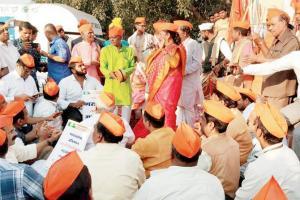Both houses pass the Bill unanimously but a concern whether the new law will face legal scrutiny remains

People sang powadas, held gondhals, dressed like mavle (Chhatrapati Shivaji's soliders) and held rallies to celebrate the reservation in Pune. Many danced on the roads. Pune city BJP president Yogesh Gogawale said the Maratha community has got justice.
After a hullabaloo in both the houses over the past two weeks, the Maharashtra Legislature passed a Bill on Thursday to grant the distressed Maratha community, a 16% quota in jobs and education in a separate category, without debate and opposition.
The Maratha reservation will be in addition to the existing cap of 50% so the right of other backward communities isn't affected. The law will come into force immediately after the governor ratifies it in a couple of days, sources said.
The Bill and Action Taken Report (ATR) on the State Backward Class Commission's recommendations was tabled by Chief Minister Devendra Fadnavis in the legislature on Thursday, a day before the winter session's culmination on Friday. The Act is called the Maharashtra State Reservation (of seats for admission in educational institutes in the state and for appointments in the public services and posts under the state) for Socially and Educationally Backward Classes (SEBC) Act, 2018.
ADVERTISEMENT
Though this ended the anxiety in the politically dominant Maratha community that has been protesting for the quota for the past 40 years, a concern whether the new law would pass legal scrutiny remained. Many from the non-Maratha community have threatened to challenge the quota in the court. A legal challenge in 2014 had the previous government's decision scrapped by the Bombay High Court.
Reasons for the quota
Explaining the extraordinary circumstances for crossing the 50% limit for reservation, the Act says in detail why it has given Marathas a 16% quota, in addition to the existing reservation, based on the quantifiable data and its consequential entitlements to the constitutional reservation benefits.
The Act and ATR say Marathas constitute 30% of the state's population but most are educationally, economically and socially backward. The survey gave the community 21.5 marks out of the maximum 25 while recommending a 16% quota. The Act further says representation of Marathas in the state public employment in the higher grade of A, B, C and D is found to be inadequate not only as a proportion of their state population share (30%) but also because of inadequacy in the number of graduates which is the minimum qualification for these posts. The community scored a low of 8 out of 25 marks for determining the educational backwardness. There are 13.42% illiterates, 35.31% primary educated, 43.79% HSC and SSC, 6.71% under/post graduates and 0.77% technical and professional qualified.
Around 76.86 families rely solely on agriculture and agricultural labour for their livelihood. Only 6% Marathas are in government and semi-government services. Women in the community are most backward as 88.81% of them are involved in physical labour to earn their livelihood.
Around 93% families have an annual income of Rs 1 lakh which is much below the average income of middle class families. The BPL families (annual income less than Rs 50,000) are much higher (37.28%) against the state average of 24.2%.
Contrary to assumption that Marathas are landlords, the Act says the community's 71% are landless and marginal farmers (land ownership of less than 2 acres). Farmers holding about 10 acres of land are only 2.7%.
Backward till 1952, excluded without reason
The Marathas have suffered the most for not allowing the breach of 50% reservation limit on one hand, and on the other, being tagged with the Forward Class of citizens to face an unequal competition with them. They, in fact, had been included in the backward category before the independence, and till year 1952, were being included in intermediate caste category, an old version of the new incarnation of SEBC.
Most of the other caste groups then included in the intermediate caste category along with Marathas, or even those who did not find a place in the intermediate caste category then are now in the list of backward classes. The Marathas had been excluded without any reason and tagged with Forward Class Citizens to face a stiff unequal competition.
Catch up on all the latest Mumbai news, crime news, current affairs, and also a complete guide on Mumbai from food to things to do and events across the city here. Also download the new mid-day Android and iOS apps to get latest updates
 Subscribe today by clicking the link and stay updated with the latest news!" Click here!
Subscribe today by clicking the link and stay updated with the latest news!" Click here!







